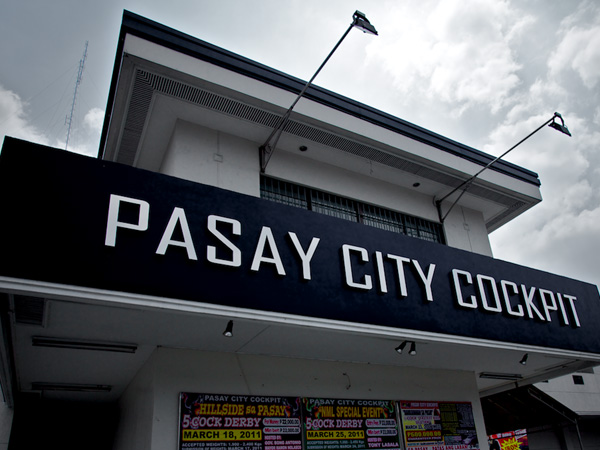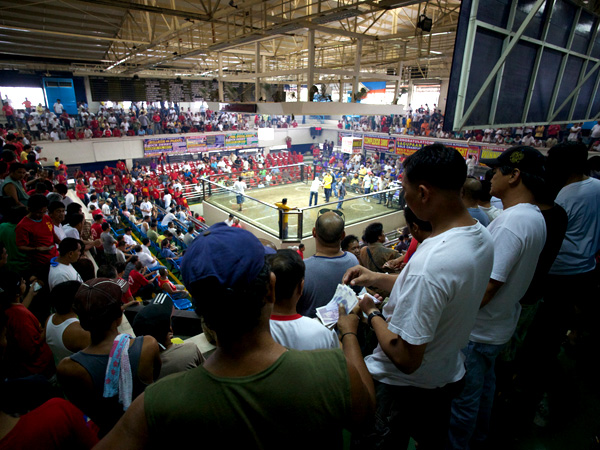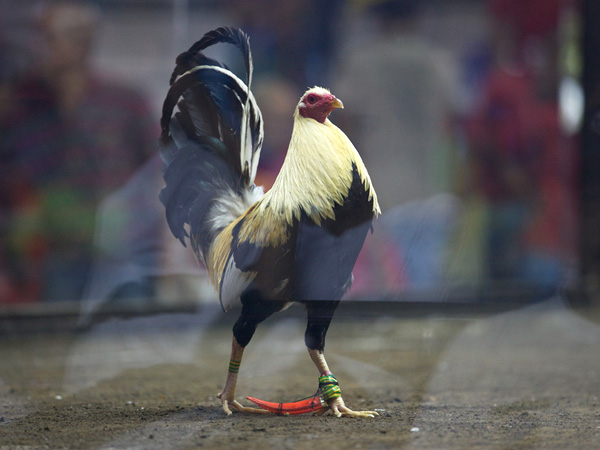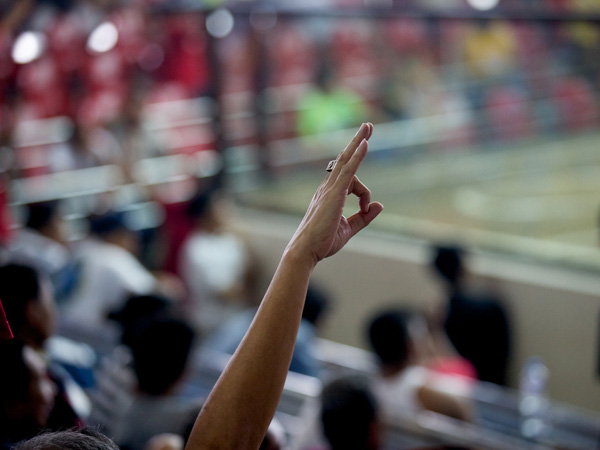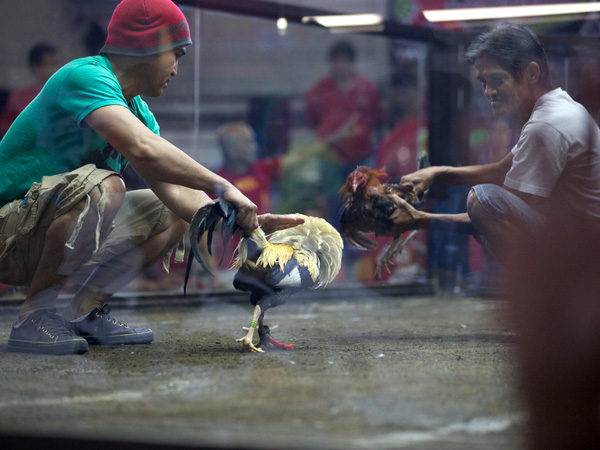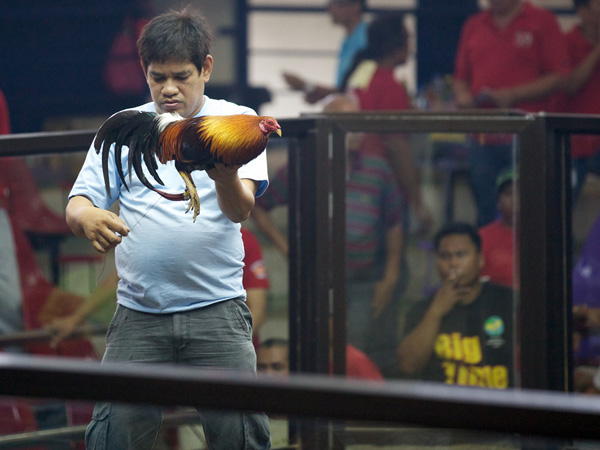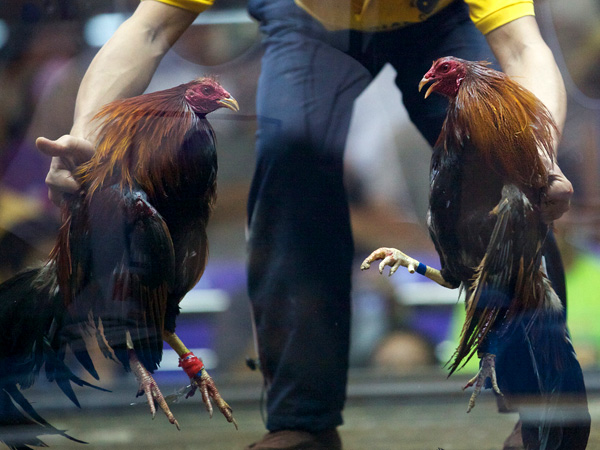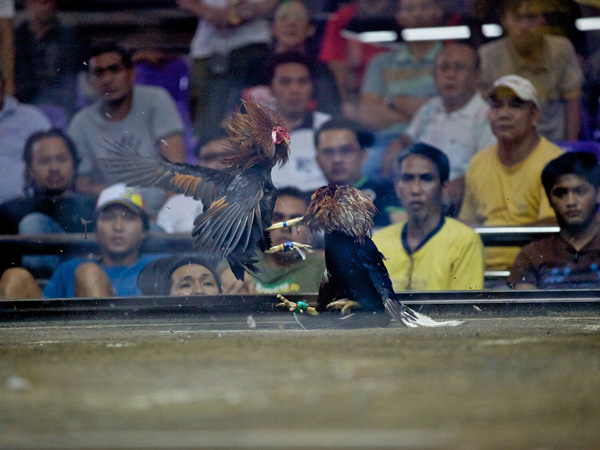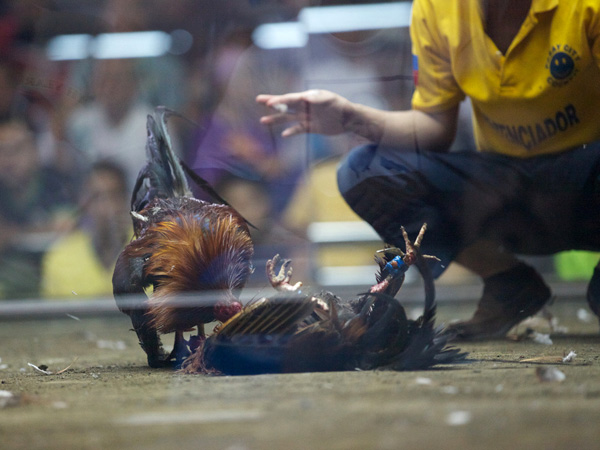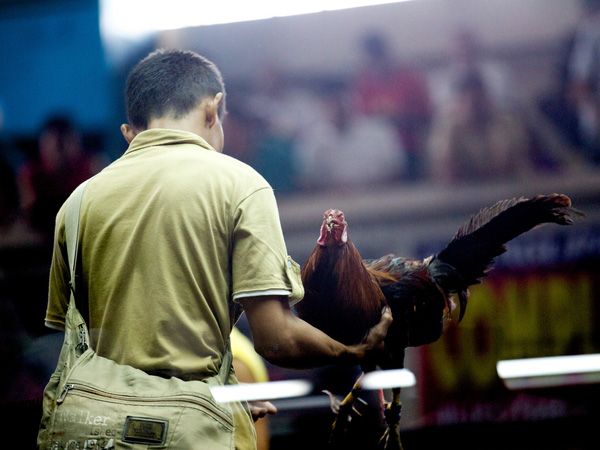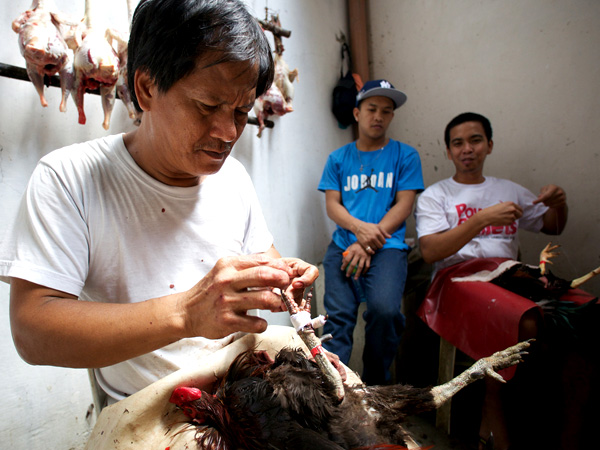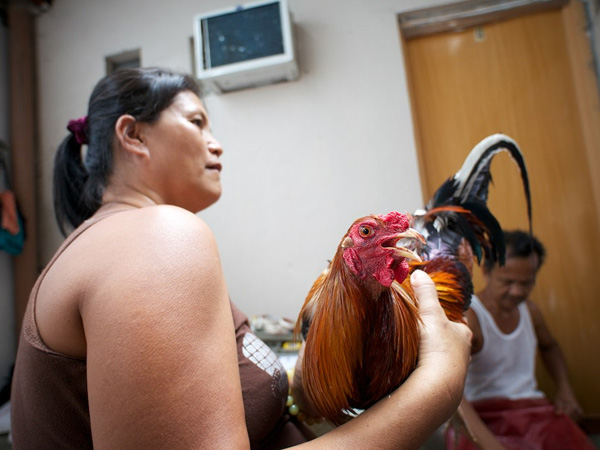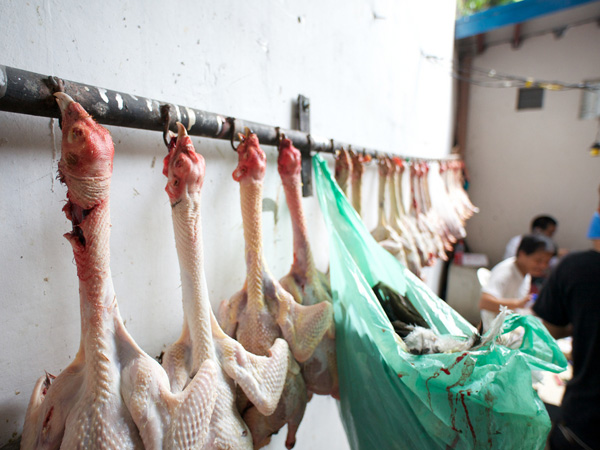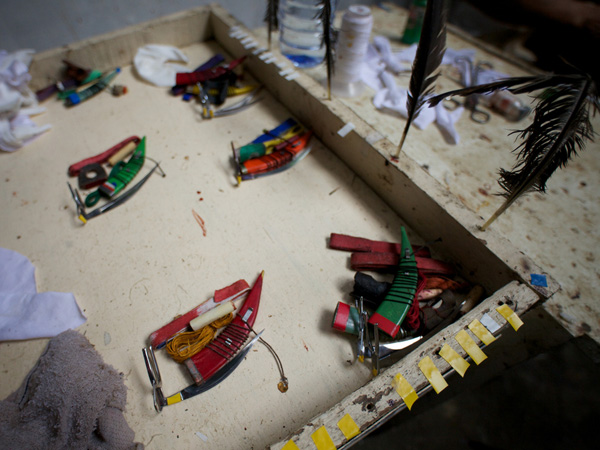Tempting Fate in the Philippines
Gun-toting cabbies and knife-toting chickens.
MANILA—Tourists know the Philippines for its sparkling beaches and brilliant coral reefs. Outside the resorts, there's a more ominous landscape of rabid animals, crumbling mountaintops, and dangerous typhoons. The man-made hazards are no less severe: Anti-government guerrillas, organized criminals, and street thugs are said to populate the islands. On my first day in Manila, I come across an editorial in an English-language newspaper that mentions a recent "craze for kidnapping." The author's offhand tone makes the abductors sound like guys who wear dress shoes without socks.
Yet optimism abounds in the South Seas. Amid the jungles and shantytowns, under the constant threat of bomb blasts and banditos, local authorities have embarked upon a campaign to rebrand their country. In the quiet week between December's floods and a January avalanche, the secretary of tourism announced a new national slogan: "It's more fun in the Philippines."
After a few days here, I’d suggest a different slogan: “The Philippines—where everyone is packing heat.” Uniformed guards stand outside banks and convenience stores, swinging semiautomatic shotguns on shoulder straps. At a domestic airport, there's a sign near the main entrance reminding Filipinos that "high-powered long firearms are not permitted past this point." (No word on low-powered firearms.) Eventually, I'm even holding a gun myself.
My driver, Tony, hands it to me as we careen toward Manila. "I also have a .45 and an Uzi," he says, beaming. "There are three magazines under the seat. Fifty bullets. Pow pow pow!" He watches me curl my finger around the trigger and winces. "Give that back," he says, and grabs the gun so he can remove the live ammo.
Tony's worried about what he sees as an ever-present threat on Filipino highways: motorcycle pirates. The gangs are everywhere, he tells me. They swarm around SUVs, force them off the road, and kill everyone inside. It's not the first time I'm left to wonder whether someone I've met in the Philippines is savvy, overcautious, or totally insane.
Tony's driving suggests the latter. A former drag-racer, he likes to move straight ahead at very high speeds; when another car gets in the way, he zooms up on its fender and leans on the horn until it changes lanes. "How do you like my driving?" he asks, swerving into a narrow slot between a bus and a sedan. And then, before I can answer: "Hey, do you want to come with me to the shooting range?"
None of the other cabbies I meet on my trip are so Taxi Driver. They're just as afraid of carjackings—who isn't, really?—but they lack Tony's gun-toting bravado. Nearly every time I get into a car, the first thing the driver does is reach back and click both rear locks shut. "Where are you going, sir?" he asks, with a look that says, I'll try not to get us both killed on the way.
If I'm making the Philippines sound like a scary place, that's because the Philippines is a scary place. Still, I find it hard to get worked up over my personal safety with so many fluent English-speakers around, and the signposts of Western culture visible from every street corner. It’s not quite right to describe Manila as an Americanized city. Americanized suggests a foreign culture that's been lightly seasoned with U.S. brands—some Quiznos and Burger Kings, a Banana Republic here and there. A better adjective for this loud and messy mega-city of 12 million, still caked with the legacy of U.S. colonial involvement, would be Americanesque. The place feels like a grotesque version of America.
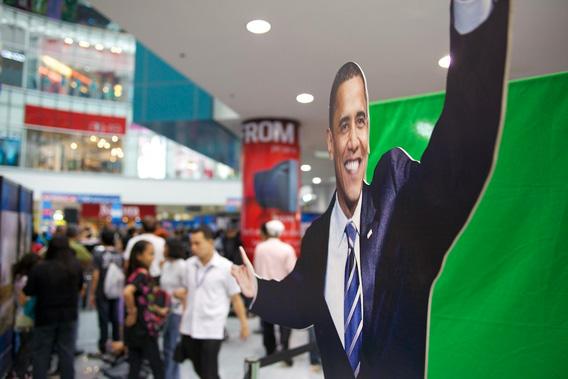
Photograph by Matt Elkind for Slate.
It's not just the guns and the mall-store transplants. The social inequality, too, makes our own seem trivial. My photographer, who's traveled extensively in Southeast Asia, is taken aback. "It's like a poor man's Bangkok," he says as we drive past a community of street-dwellers on the way to Roxas Boulevard. "No, wait, it's an even poorer man's Bangkok."
We'd read stories about the slums here, and the scavengers who die in collapsing mountains of garbage. But Manila's poverty is more direct, expansive, and confrontational than any I've seen. In India, child beggars nag tourists by grabbing at their elbows and shoving worthless souvenirs into their hands; here the street kids say, "Give me money," and if you refuse, they ask "Why not?" and stare at you with folded arms until you answer.
One afternoon we find ourselves in a glitzy shopping center in the northern part of the city, where the U.S. Embassy is staging a weekend bonanza called "America in 3-D." It’s a cultural primer for curious Filipinos: There's a '66 Chevy Corvette Sting Ray and a '57 Chevy convertible sitting in the middle of a mall plaza, surrounded by tables giving out information on Welch's grape juice, Celestial Seasonings herbal tea, and Easy Pop gourmet snacks. On a temporary stage, a hip-hop dance crew called the Philippine All-Stars is teaching the crowd how to do the Cabbage Patch and the Smurf. A bit later, there will be a screening of the film Meet the Parents—the brochure says it's supposed to teach Pinoys about American family life.
The cultural fair is surrounded by American chain stores. I watch the hip-hop dancers while standing next to a Guess outlet and a restaurant called Gumbo: A Taste of New Orleans. And it's not clear why they're bothering to screen Meet the Parents when the movie theater's marquee already shows a full bill of Hollywood cinema. "It seems like Filipinos already know a lot about American culture," I remark to an embassy worker.
"Well, obviously," he says, laughing.
Yet all the Americanism or American-ness can seem like a flimsy overlay when you visit the neighborhoods. "No cockfight in U.S.," a man tells me at one point, with a pitying look. "Cruelty to animals, tsk, tsk."
Bird-on-bird combat is a pillar of Filipino culture, and there are pits in every village. At a large, crowded venue in Manila, the cocks leap toward each other in a fluff and tumble of loose feathers, and when they land a moment later one of the pair has been mortally wounded. In the most dramatic bouts, the animals lock eyes, circle the turf, and then jump over each other's heads. I can't really follow what's happening, but the crowd yells, waving their hands, and tossing wads of crumpled bills from the balcony to the bet-takers below.
Despite a certain Catholic prudishness from some quarters, gambling is rampant on the islands. It's not just cockfighting: Pinoys indulge in the occasional horsefight, bull-on-bull bullfighting and—for the kids—spider-wrestling. (A boy might keep his spider in a matchbox hung from a loop around his neck.) There's a national lotto, hundreds of bingo parlors, and more than a dozen government-run casinos and slot clubs, which together put some $800 million per year in the Filipino treasury. In spite of all this—and an ongoing multi-billion-dollar project to create a gambling-oriented "Entertainment City" in Manila—illegal numbers games are widespread. Scandals stemming from the ubiquitous, gang-run lottery known as jueteng brought down a former president.
Sociologists say that on an individual level, Filipinos have no more proclivity for gambling than any of their neighbors in Southeast Asia. Yet as I make my way around the country I can't help but wonder if the vagaries of life on the archipelago might encourage a gambler's sensibility. It seems in character when the Manila Times runs news on the latest predictions from a geomancer named Joseph Chau. The master has declared that the Philippines is due for a year of good luck. It's welcome news, but comes with an important caveat: "There will be more flooding, raining, earthquakes, and more explosions," says Chau. Maybe that's a lesson for would-be tourists. (It's certainly one the locals have learned from their centuries of war and tumult.) You just can't win 'em all.

